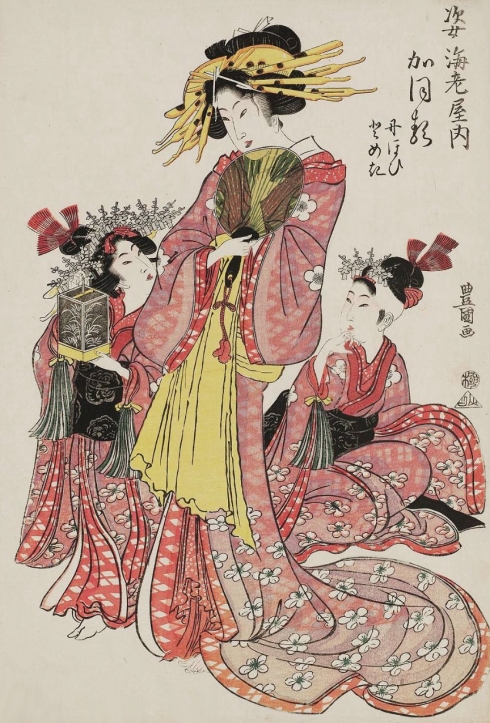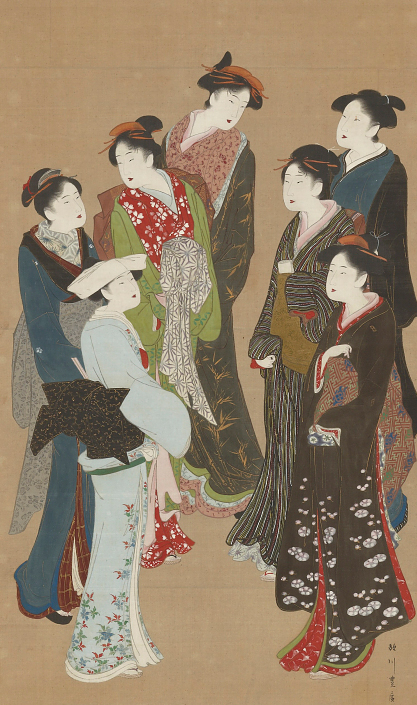Kitagawa Utamaro, Stampa japoneza (Ukiyo-e): Ciresi infloriti, Yoshiwara, Perioada Edo, 1788-1791, Wadsworth Atheneum Museum of Art.
Kitagawa Utamaro, Femei in zapada
Ando Hiroshige, Fujikawa, 1840-42, Museum of Fine Arts, Boston
Japanese Ukiyo-e Prints
26JUNUkiyo-e is a genre of woodblock prints that flourished in the Edo period (1603-1867). Term ‘Ukiyo-e’ literally means ‘pictures of the floating world‘ as it was meant to describe the hedonistic lifestyle of the merchant class that benefited from the rapid economical growth in Edo (modern Tokyo). Merchant class, previously at the bottom of the social order, now had enough wealth to indulge in all sorts of pleasures; from kabuki theatre to services of courtesans and geishas. Courtesan culture also flourished in Edo period, and male wanderers could find a refined female company in the ‘pleasure quarter’. On the other hand, geishas are female entertainers and hostesses, skilled in different areas such as calligraphy or dance. Courtesans were describes as ‘colourful flowers’ while geisha women were called ‘willows’ because of their subtlety, strength, and grace. In addition to all this, merchant class had enough money to afford a new art or design items, depends on how you look at it. I suppose some people really appreciated the beauty of Ukiyo-e prints while others merely enjoyed having them on the wall.
Ukiyo-e prints have a wide range of subjects and styles, depending on the artist and on the time period. The pictures below are my personal favourites, though I’ve also wanted to present you the variety of these artworks and Japanese culture. Woman Bathing Under Flowers is perhaps my top-favourite. However, as a true European my mind instantly compares these works with European artworks of the time. I mean, some of these works were created in the early nineteenth century – the same years that Jane Austen’s novels were written. It’s so exciting to encounter a different era, a different culture, if not in person, than through these lavishing woodblock prints – overwhelmingly simplistic, but dynamic, colourful, scenes from the world gone by.
The great diversity that excites me, and I hope you too, can be traced through the work of the various artists – from the famous Hokusai’s waves or Hiroshige’s nocturnal landscapes to Keisai Eisen’s ‘beautiful women’, Sharaku’s kabuki actors, Torii Kiyonaga’s mystical night scenes, to my personal favourite – Utagawa Toyokuni who, as you can see, focused on everyday scenes, especially women’s activities – bathing, applying makeup, calming hair, strolling in the rain (probably worried for the hairstyle), playing with dogs or cats, dancing or showing off in front of your friends – typical activities of the modern women. It seems like time changes, but people, their worries, fears and passions usually stay the same. Imagine, Utagawa Kunisada’s beauties in the print ‘Autumn moon over Miho’ admired the very same moon we see today.
I must add that Ukiyo-e prints were hugely influential on European art, especially on the Impressionists and Postimpressionist such as Vincent van Gogh who admired some of Hokusai’s prints and also the Japanese way of living.

1857 Sudden shower over Shin-Ohashi bridge and Atake – Hiroshige

1857 The Plum Garden in Kameido – Hiroshige
https://byronsmuse.wordpress.com/tag/wodblock/
===========================================






























